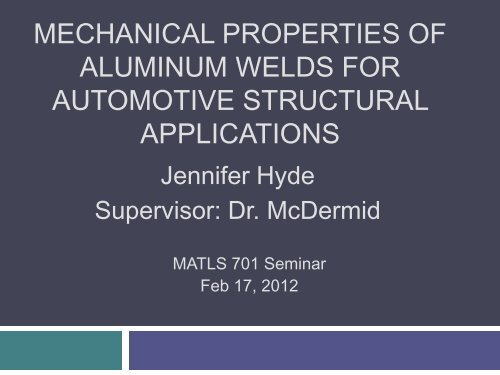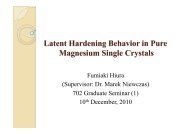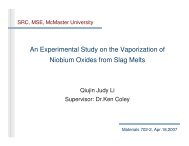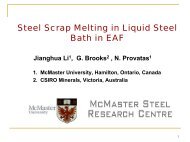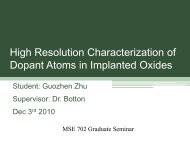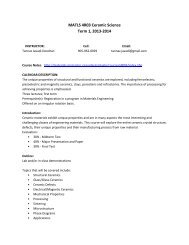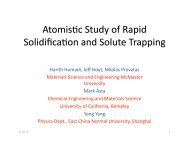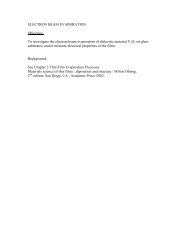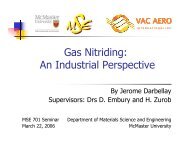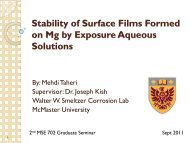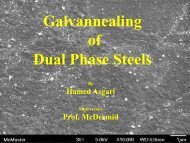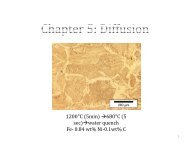Mechanical Properties of Aluminum Welds - Course Notes
Mechanical Properties of Aluminum Welds - Course Notes
Mechanical Properties of Aluminum Welds - Course Notes
You also want an ePaper? Increase the reach of your titles
YUMPU automatically turns print PDFs into web optimized ePapers that Google loves.
MECHANICAL PROPERTIES OF<br />
ALUMINUM WELDS FOR<br />
AUTOMOTIVE STRUCTURAL<br />
APPLICATIONS<br />
Jennifer Hyde<br />
Supervisor: Dr. McDermid<br />
MATLS 701 Seminar<br />
Feb 17, 2012
Outline<br />
2<br />
Motivation<br />
Background/Literature Review<br />
Project Outline<br />
Experimental Procedure<br />
Preliminary Results<br />
Summary<br />
Future Work<br />
Acknowledgements
Motivation<br />
3<br />
<br />
Increased use <strong>of</strong> aluminum for light weighting <strong>of</strong><br />
vehicles due to its relatively high strength to weight<br />
ratio<br />
The <strong>Aluminum</strong> Association. <strong>Aluminum</strong> in Transportation<br />
http://aluminumintransportation.org/main/commercial-vehicle/commercial-vehicle (Accessed Feb 2012)
Background: GMAW<br />
4<br />
Gas Metal Arc Welding<br />
(GMAW)→ two metals are joined<br />
by heating from an arc between<br />
the metal and continuously fed<br />
filler wire electrode. This process<br />
uses a shielding gas (argon or<br />
helium) to protect the molten<br />
weld pool from oxidation.<br />
<br />
<br />
Popular welding technique for Al<br />
alloys<br />
Results in 3 distinct regions:<br />
weld; HAZ; base material<br />
S. Kou, Welding Metallurgy, 2 nd ed., Hoboken,<br />
New Jersey: John Wiley and Sons Inc., 2003.<br />
Microhardness Pr<strong>of</strong>ile
<strong>Mechanical</strong> <strong>Properties</strong> <strong>of</strong> <strong>Welds</strong><br />
5<br />
Problem<br />
One <strong>of</strong> the easiest ways to get the mechanical<br />
properties <strong>of</strong> a material is from uniaxial tensile testing<br />
This is a problem for welds since the mechanical<br />
properties <strong>of</strong> welded samples from tensile testing is<br />
limited to the instability <strong>of</strong> the weakest region <strong>of</strong> the<br />
welded joint<br />
How can we measure mechanical properties<br />
<strong>of</strong> each region <strong>of</strong> the weld
<strong>Mechanical</strong> <strong>Properties</strong> <strong>of</strong> <strong>Welds</strong><br />
6<br />
Solution:<br />
1) Gleeble/thermal<br />
treatment apparatus<br />
costly<br />
time consuming<br />
Sensitive to variation <strong>of</strong><br />
welding conditions<br />
2) novel shear test; tensile<br />
testing combined with DIC<br />
modified ASTM B831 shear<br />
samples<br />
<strong>Mechanical</strong> behaviour up to<br />
large strains from shear test<br />
Gleeble 3180 Dynamic Systems Inc.<br />
http://www.gleeble.com/index.php/products/productsoverview.html<br />
(Accessed Feb 2012)
Modified Shear Samples<br />
7<br />
<br />
<br />
Machined using wire and sink EDM (Electric Discharge Machining)<br />
Pulled in a tensile testing machine
8<br />
Digital Image Correlation (DIC):<br />
ARAMIS System<br />
<br />
<br />
<br />
<br />
Spray paint test sample to get<br />
random speckle pattern and<br />
using a CCD camera to take<br />
snapshots during testing.<br />
ARAMIS calculates<br />
displacement between each<br />
snapshot and a reference<br />
picture to get strain<br />
able to calculate strain within<br />
the shear zone and also<br />
localized strain during tensile<br />
test (i.e. strain in weld; HAZ<br />
and BM regions)<br />
Relate stress to strain by time.<br />
Facets in the undeformed and deformed state<br />
(Aramis v5.3 manual, GOM mbH, Braunschweig, Germany (2004))
Shear Test: Kang et al [1]<br />
9<br />
<br />
<br />
<br />
These modified samples first<br />
used on DC and CC 5754 sheet<br />
materials<br />
This geometry prevents end<br />
rotation <strong>of</strong> the shear zone as<br />
compared to the ASTM B831<br />
samples<br />
Compared shear test to uniaxial<br />
tension tests<br />
They concluded that effective<br />
stress and strain for shear test<br />
only matched tensile results when<br />
using the Barlat-Lian yield<br />
function which incorporates<br />
planar anisotropy.<br />
[1] J. Kang et al, Journal <strong>of</strong> Engineering Materials and Technology, 031004-1-5, 2008.
10<br />
Yield Functions:<br />
For simple shear:<br />
Von Mises:<br />
Barlat-Lian:<br />
M=8 for FCC materials
Barlat-Lian Yield Function:<br />
r= plastic strain ratio<br />
Equal to 1 for an isotropic<br />
material<br />
11
Effective stress, MPa<br />
[2] Kang J, McDermid , J.R., Bruhis, M., SAE Paper, 2012-01-0181 (2012)<br />
Resistance Spot <strong>Welds</strong><br />
12<br />
<br />
More recently this modified<br />
shear sample geometry has<br />
been extended to the<br />
investigation <strong>of</strong> AA5754-O<br />
RSW welds and AA6022 T4<br />
RSW welds [2]<br />
350<br />
300<br />
250<br />
200<br />
<br />
Used Barlat-Lian equation<br />
on base materials to match<br />
tensile and shear effective<br />
stress-strain curves<br />
150<br />
100<br />
50<br />
AA5754 Uniaxial tension<br />
AA6022-T4 Uniaxial tension<br />
AA5754 von Mises<br />
AA6022-T4 von Mises<br />
AA5754 Barlat-Lian<br />
AA6022-T4 Barlat-Lian<br />
0<br />
0 0.2 0.4 0.6 0.8<br />
Effective strain<br />
Uniaxial Tension and Shear effective stressstrain<br />
curves for the base materials: 5754 and<br />
6022 T4
True stress, MPa<br />
RSW welds graph<br />
13<br />
350<br />
300<br />
s = 487.24e 0.2194<br />
R² = 0.99<br />
s= 479.83e 0.2941<br />
R 2 = 0.9898<br />
s= 321.97e 0.1409<br />
R 2 = 0.9813<br />
250<br />
s= 226.33e 0.1497<br />
200<br />
R 2 = 0.9542<br />
150<br />
AA5754-O<br />
100<br />
50<br />
0<br />
6022-T4<br />
Case 8 Tensile<br />
Case 6 Tensile<br />
Case 8 Shear<br />
Case 6 Shear<br />
Case 6 Shear<br />
0 0.05 0.1 0.15 0.2 0.25 0.3 0.35 0.4 0.45<br />
True strain<br />
Case 6: RSW 6022 T4 Case 8: RSW 5754-O
Research Objective<br />
14<br />
GM currently cannot accurately predict the failure<br />
location <strong>of</strong> gas metal arc welded aluminum<br />
structural components<br />
This research meant to provide the necessary<br />
mechanical property information for both the weld<br />
region and the HAZ so that their FE models are<br />
accurate
Project Outline<br />
15<br />
Weld Cases<br />
Case Material 1 Thickness Material 2 Thickness Weld wire<br />
1 Aural 2 T7 3mm 6063 T4 4mm 4043<br />
2 Aural 2 T7 3mm 6063 T6 4mm 4043<br />
3 5754-O 3mm 6063 T4 4mm 4043<br />
4 5754-O 3mm 6063 T6 4mm 4043<br />
9 5754-O 3mm 5754-O 3mm 4043<br />
<br />
<br />
These are in a butt joint configuration for testing purposes<br />
Also testing base materials mechanical properties
Base Materials<br />
16<br />
AA 5754-O<br />
Main alloying element is Mg<br />
Non-heat treatable<br />
O temper → fully annealed<br />
<br />
AA 6063 T4 and T6<br />
Mg and Si are the main alloying elements<br />
heat treatable→ strengthening from metastable β'' precipitates (Mg 2 Si)<br />
T4 → naturally aged; T6 → optimally aged<br />
<br />
Aural-2 ® T7<br />
Mg, Si and Mn are the main alloying elements<br />
die cast<br />
T7 → stabilized
Weld Configuration<br />
17<br />
(A)<br />
(B)<br />
RD<br />
RD<br />
RD<br />
RD<br />
Cases 1 and 2<br />
(C)<br />
Case 1<br />
RD<br />
RD<br />
5754<br />
Cases 3 and 4
Paint Bake Cycle<br />
18<br />
Al alloys used for automotive applications undergo<br />
a paint bake cycle which may have an effect on<br />
the material’s properties given that many Al alloys<br />
are artificially aged around this temperature<br />
Baking Conditions:<br />
180°C for 20 mins then air cool, reheat to 180°C for 30 mins<br />
All base material samples with the exception <strong>of</strong><br />
5754-O tested in this condition<br />
All welds were tested in this condition which is<br />
meant to simulate the paint bake cycle.
Experimental Procedure<br />
19<br />
<strong>Mechanical</strong> Testing<br />
Tensile Tests<br />
Base Materials<br />
<strong>Welds</strong><br />
Shear Tests<br />
Base Materials<br />
<strong>Welds</strong><br />
HAZ<br />
Locating the HAZ to place<br />
shear zones<br />
Microhardness Pr<strong>of</strong>iles<br />
Microstructure<br />
OM (Electrolytic etching using<br />
Barker’s and viewing under cross<br />
polarized light)<br />
Fractography<br />
SEM on fracture surfaces
Tensile Tests<br />
20<br />
<br />
Base Material:<br />
Tensile samples cut parallel (0°), 45° and 90° to RD<br />
Extensometer as well as ARAMIS (DIC) for strain measurements<br />
Strain rate: 6.7 x 10 -4 /s<br />
<br />
<strong>Welds</strong>:<br />
Weld in middle <strong>of</strong> tensile sample<br />
ARAMIS used for strain measurements<br />
Strain rate: 2.8 x 10 -4 /s<br />
<br />
10 KN Instron Testing Machine
6063 T4 Stress-Strain Curves<br />
21<br />
6063 T4 AR 6063 T4 B
Tensile Test <strong>of</strong> <strong>Welds</strong>: 1A:6063 T4 and Aural-2 T7<br />
22<br />
1A AR<br />
1A B
Shear Test samples: welds<br />
23<br />
Welded Plate<br />
Shear Sample
24<br />
Locating the HAZ for Shear Test
Shear Tests- Base Materials<br />
25<br />
<br />
Same machine as tensile test<br />
Testing base material samples parallel and transverse to<br />
RD (0° and 90°)<br />
Strain rate: 2.6 x 10 -3 /s<br />
Using Aramis/DIC to directly measure shear angle<br />
at each stage<br />
<br />
Shear stress and strain converted to effective stress and<br />
strain using von Mises criterion
Aural-2 T7 Shear Curves<br />
26
Summary<br />
27<br />
<br />
<br />
<br />
<br />
Tensile tests on base materials were completed with general<br />
agreement between samples and some differences in<br />
sample orientation (i.e. 0°, 45°, 90° wrt RD)<br />
Tensile test on welds using ARAMIS (DIC) were able to show<br />
strain locally; in both the weld region and region where<br />
fracture occurs<br />
It has been found that only 6063 T6 has a noticeable HAZ<br />
Shear tests on base materials were completed. The effective<br />
stress-strain curves show differences for shear and tension.
Future Work<br />
28<br />
Locate the fusion zone <strong>of</strong> 6063 T4, 5754-O,<br />
Aural 2 T7 and then place the shear zone<br />
beside this region<br />
Shear tests on welds and HAZ<br />
SEM <strong>of</strong> fracture surfaces<br />
Possibly use Barlat-Lian yield function to<br />
incorporate material anisotropy
Acknowledgements<br />
29<br />
General Motors <strong>of</strong> Canada Ltd for financial<br />
support and experimental materials<br />
Initiative for Automotive Manufacturing Innovation<br />
(IAMI) for financial support<br />
Supervisor: Dr. McDermid<br />
Technical assistance: Jidong Kang; Mike Bruhis;<br />
and Doug Culley
QUESTIONS


